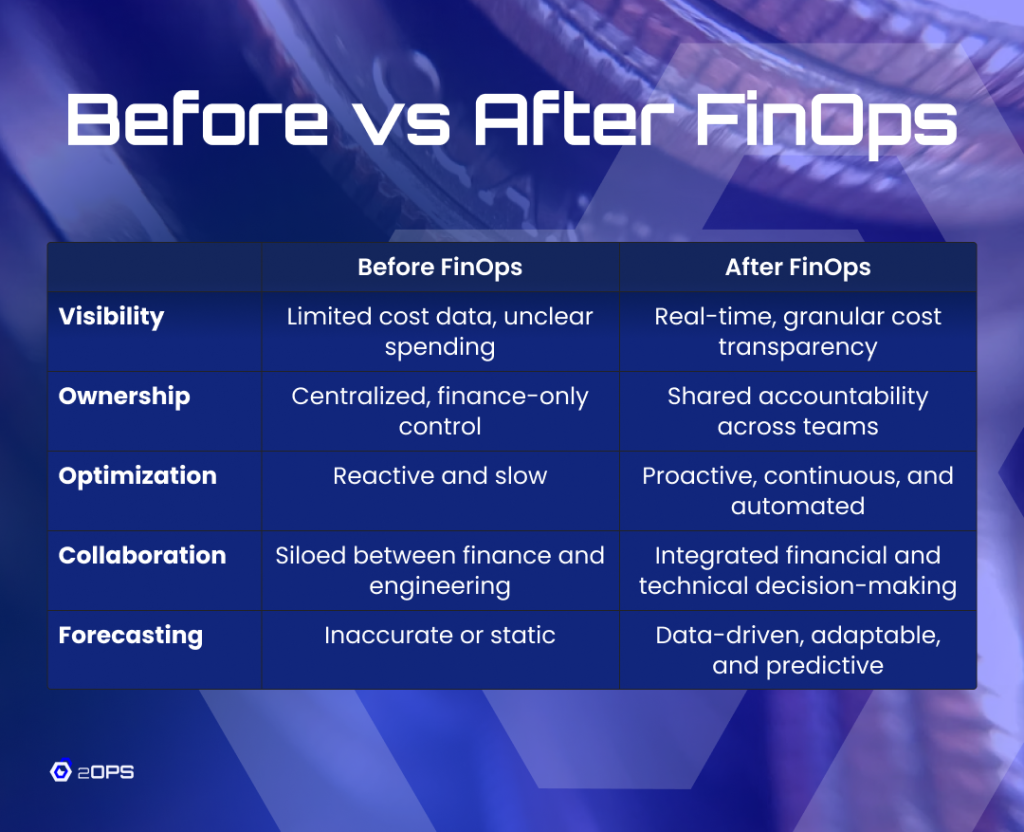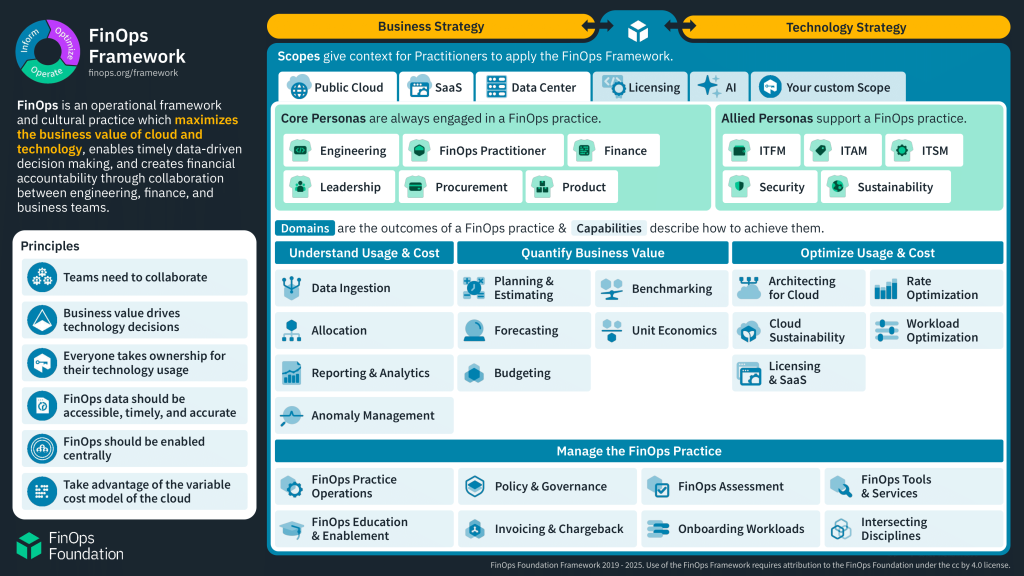Table of Contents
Introduction: Why FinOps Matters Today
Cloud computing has transformed how organizations build and deliver technology, but it has also introduced a new challenge: skyrocketing and unpredictable costs. Without the right approach, cloud spending can quickly spiral out of control, straining budgets and creating unnecessary risk.
FinOps, short for “Financial Operations,” is a discipline that brings financial accountability to the cloud. It combines systems, best practices, and culture to help engineering, finance, and business teams collaborate on managing cloud spending in a more transparent and efficient way.
What is FinOps?
FinOps is a cloud financial management practice designed to optimize cloud costs while maintaining speed and innovation. It ensures that everyone involved in deploying and maintaining cloud systems has a shared responsibility for costs.
In modern cloud-native organizations, FinOps complements DevOps and CloudOps by adding a financial dimension. Where DevOps accelerates delivery and CloudOps ensures operational reliability, FinOps brings cost governance and financial visibility to the table.
Key Benefits of FinOps
Cost transparency
FinOps gives teams a clear and detailed view of all cloud-related expenses across the organization. It helps identify where money is being spent, breaking down costs by service, department, or project. Better visibility supports more accurate forecasting and prevents overspending.
Shared accountability between engineering and finance
FinOps encourages a culture where both engineering and finance teams take ownership of cloud costs. Collaboration improves, with financial goals factored into technical decisions. This empowers individual teams to manage their budgets more responsibly.
Faster decision making
FinOps provides real-time data and dashboards that let teams react quickly to cost spikes or inefficiencies. There is no need to wait for monthly financial reviews, allowing for more agile cost optimization.
Cost optimization
FinOps frameworks identify and eliminate wasteful spending, helping organizations get the most value from their cloud investments.
Improved forecasting
Using analytics and reporting, FinOps predicts future cloud costs to support better financial planning and avoid surprises.
Enhanced financial control
FinOps gives organizations the tools and processes to monitor, report, and manage cloud budgets with greater precision and confidence.
What Problems Does FinOps Solve?
FinOps addresses many of the pain points companies face in cloud environments:
- Unpredictable cloud bills
- Lack of ownership and accountability for cloud spending
- Delayed or reactive cost optimization

How FinOps Works: The Process
FinOps generally follows a structured process built around three key steps: Analysis, Setup & Management, and Recommendations & Operation. Each step includes targeted activities, tools, and goals that together build a sustainable framework for financial governance in the cloud.
Analysis is the starting point, focused on gaining a comprehensive view of cloud costs. This involves data collection, breaking down expenditures, and identifying the main cost drivers across services, teams, and projects. Cost analysis tools and cloud expense management platforms support this work, providing visualizations like heat maps and distribution graphs to help teams see exactly where money is going.
Setup and Management comes next, establishing effective budgeting and tracking systems. Organizations plan and allocate budgets, monitor consumption in real time, and make adjustments as priorities shift. Budget management platforms and live tracking dashboards provide the transparency needed to make data-driven decisions, while budget allocation charts and variance analysis reports help identify imbalances and potential savings.
Recommendations and Operation is the ongoing improvement phase. Here, organizations carry out efficiency audits, develop optimization strategies, and implement changes to maximize their cloud investment. Tools like predictive analytics and optimization frameworks highlight cost-saving opportunities, while impact assessment diagrams and periodic reviews ensure the business continues to meet financial and operational goals.
Together, these three steps create a continuous loop of insight, action, and improvement, allowing FinOps to deliver predictable, efficient, and well-managed cloud spending across the organization.
What is FinOps Framework?
The FinOps Framework is a flexible, community-driven model that guides organizations in building and scaling their FinOps practice. It combines operational building blocks with cultural principles to help companies get the most business value from their cloud investments.
At its core, the framework promotes financial accountability through collaboration between engineering and finance teams. It also supports timely, data-driven decision making that aligns cloud spending with real business objectives.

How Organizations Use It
The FinOps Framework is modular and non-prescriptive, allowing teams to begin with the areas that deliver the most immediate impact. Organizations can adopt individual components based on current needs, then expand their FinOps practice over time as business requirements and cloud usage evolve.
For example:
- A startup might begin by introducing basic cost allocation and tagging, helping engineering and finance teams gain visibility into which services or features drive the most cloud spend. As the company grows, it can add forecasting tools, budget tracking, and anomaly detection to prevent waste and plan for scale.
- A mid-market business may use the framework to formalize cost ownership, set up regular budget reviews, and build real-time alerting for usage spikes.
- Enterprises operating in multi-cloud environments often apply the framework to unify financial oversight across departments, introduce chargeback models, and create role-based dashboards for executives, engineers, and finance teams. By aligning FinOps activities with the organization’s size, goals, and cloud maturity, companies can build a practice that evolves in both scope and impact.
Conclusion & Next Steps
FinOps is essential for modern organizations that rely on the cloud to deliver services at scale. It helps businesses maintain financial control, build a culture of cost accountability, and continuously improve their operations. With its frameworks and best practices, FinOps supports not only cost savings but smarter, more strategic use of cloud resources.
If you are ready to bring FinOps practices to your organization, 2Ops can help. Our team of cloud cost optimization specialists will guide you through building a successful FinOps framework. Reach out today to learn how we can partner on making your cloud investments more efficient and predictable.

